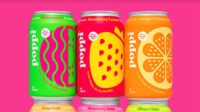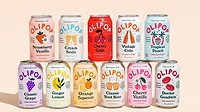Special Report
Sugar is out, functionality is in for soft drink market
What’s popping with carbonated soft drinks

Zevia PBC, the zero sugar, naturally sweetened beverage company, announced it will unveil a fresh look and feel for the entire portfolio in 2023.
Image courtesy of Zevia PBC
In 2018, Business Insider called attention to a question everyone wants to know: Is it soda or pop? The answer, as denoted in the article by Mark Abadi, stems from a web project by Alan McConchie titled “Pop Vs. Soda,” where more than 400,000 people voted. The statistics, last generated in August 2015, showed that the term people use for carbonated soft drinks (CSDs) all depends on where you grew up.
Regardless of what you call CSDs, sales of these beverages “have gone flat” in the United States over the past year, according to Arielle Rose, senior industry research analyst at New York-based IBISWorld.
Rose suggests the performance is due to the health concerns surrounding CSDs.
“The government, media platforms and even soft drink producers themselves have vocalized the consequences of consuming artificially sweetened diet soda and how drinking large volumes of regular soda can lead to obesity,” she says. “Studies during the pandemic have linked soda consumption with severe cases and virus deaths, as sugar tends to lead to comorbidities including obesity, diabetes and hypertension.”
Rose adds that laws limiting soda sales, as well as taxes on soda, have put a damper on the final sales of CSDs. Additionally, consumers are now prioritizing healthier beverages above traditional CSDs, she explains.
“While traditional carbonated soft drinks [sales] have plunged, many producers have been incorporating new products to retain consumer demand, including low- and zero-calorie versions of carbonated soft drinks, as well as non-carbonated options to cater to health-conscious consumers,” Rose says.
Gary Hemphill, managing director of Beverage Marketing Corporation (BMC), says that the CSD category “has proven to be resilient in the face of higher prices and intense competition from other categories.”
Sugar is out, functionality is in
As more beverage producers have adapted to consumers wanting less sugar in their beverages, this has encouraged CSD producers to “diversify their product offerings,” helping them stay afloat amid a sinking traditional market, IBISWorld’s Rose notes.
“To counter declining sales of traditional carbonated soft drinks, producers have expanded low- and zero-calorie offerings often sweetened with supposed non-nutritive sweeteners like aspartame, sucralose or stevia,” she explains. “Additionally, some companies have shifted their focus toward non-carbonated beverage options, including bottled water, flavored water and ready-to-drink teas, which tend to be lower in sugar and calories.”
BMC’s Hemphill echoes similar sentiments, noting that reduced sugar soft drinks are driving growth in the category.
“Improvements in taste thanks to newer sweeteners have helped to drive the growth. … The growth of reduced sugar CSDs has been the most important driver in the success of the category,” he says. “In addition, performance of the foodservice channel continues to improve, as many consumers strive to move beyond COVID-19.”
Big brands like Purchase, N.Y.-based PepsiCo are fine tuning their zero sugar beverages. PepsiCo announced a new and improved Pepsi Zero Sugar, with an upgraded recipe that uses a new sweetener system to achieve a bolder taste.
Manufacturers also are including zero sugar as part of line extensions. In February, Keurig Dr Pepper Inc. (KDP), Burlington, Mass., and Frisco, Texas, unveiled its newest flavor innovation: Strawberries & Cream, which comes in Regular, as well as Zero Sugar.

Image courtesy of Keurig Dr Pepper
“Dr Pepper Strawberries & Cream is an exciting evolution for our brand’s flavor portfolio as it joins our permanent lineup alongside popular varieties such as Dr Pepper & Cream Soda and Dr Pepper Zero Sugar,” said John Alvarado, senior vice president of Dr Pepper Brand Marketing, in a statement. “We can’t wait for people to try this delicious new treat.”
Atlanta-based The Coca-Cola Co., in collaboration with Grammy-award winning artist Rosalía, recently unveiled its limited-edition Coca Cola Move, the latest drop under Coca Cola Creations. Coca Cola Move, which features vibrant pink sketch-like packaging, also is available in zero sugar.
BMC’s Hemphill calls attention to the activity in new flavor options, but notes it still has its obstacles.
“Flavor innovation continues to bring meaningful innovation to the category, but the challenge has been to maintain the growth of a new flavor,” he says.
IBISWorld’s Rose adds that new CSD flavorings can attract a larger consumer base. As consumer preferences have shifted toward healthier and more natural products, “a new niche” of craft CSDs has emerged, she says.
“Additionally, these producers have diversified their carbonated soft drink product portfolio with new flavors to capture more consumer attention,” she notes. “For example, limited edition seasonal or holiday flavors, flavor fusions combining two or more flavors and natural flavors derived from plants or fruit have proven successful for soft drink producers.”
Moreover, with more consumers seeking drinks with health benefits and functional properties, this propels CSD producers to deliver, Rose says.
“First off, CSD producers have implemented low-sugar and low-calorie options, appealing to health-conscious consumers looking to cut down on their sugar intake,” she explains. “Also, some CSDs are now infused with vitamins like B12 or C, which are perceived to offer immune support or enhanced energy.”
Smart Soda was an early adopter of this trend when it introduced flavored sparkling alkaline waters and sodas, Rose says, and they are made with organic cane sugar and infused with vitamins. And companies like The Coca-Cola Co. are offering energy and coffee-infused CSD options, which often deliver “an extra boost of energy, while retaining a traditional soda flavor,” she adds.
“We’re seeing more functional CSDs come to market, especially with regard to pre- and probiotics,” BMC’s Hemphill says. “Still, while the number of brands is growing, they represent a small part of the overall CSD category.”
What’s popping with CSDs
In addition to sugar reduction trends, the CSD market has seen other trends influence packaging as well as new product development.
IBISWorld’s Rose says that consumers needing to improve their time management are often looking for convenient, on-the-go options of their favorite CSDs.
“This has contributed to more producers offering portable and single-serve options,” she explains. “Another consumer trend has surrounded health and wellness, prompting soft drink producers to create artisanal, craft options with natural sweeteners and, overall, healthier ingredients. Many consumers are willing to pay more for these beverages that are considered higher quality and premium, compared with traditional carbonated soft drinks.”
Rose also notes that sustainability is important to consumers, which could impact the type of ingredients and packaging that beverage-makers use.
Hybridization is another trend that has encouraged producers to diversify their offerings, Rose says.
“In that regard, many beverage manufacturers have incorporated CSD varieties with flavor blends, as well as blends of soda with other beverage categories,” she explains. “For example, some producers have blended soda with tea, juice, energy drinks and coffee to appeal to ever-changing consumer tastes.”
She cites Coca-Cola with Coffee as an example of hybridization. The beverage contains “nearly double the amount of caffeine compared with a traditional can of Coke.”

And while the craft CSD space remains niche, Rose says that their popularity has expanded upon consumers looking for unique beverages.
“Most craft beverage producers are known for their natural ingredients, including natural sweeteners like agave or honey, cane sugar and juices from real fruit,” Rose notes. “Also, some craft CSDs are offered in special flavors not found in mass-produced traditional CSDs, such as ginger, cinnamon, coffee and cucumber.”
These craft soda brands are often known for utilizing locally sourced ingredients, bold packaging and appealing brand, which Rose says can further entice consumers. At the same time, BMC’s Hemphill notes that it can be a struggle for craft CSDs to compete with big category brands.
Going forward, Rose suggests that CSD producers will have to continue to adapt and evolve as consumers move away from the traditional CSD scene. Healthier, more functional beverages, hybrid CSDs, personalized products and sustainable packaging are just a few trends that Rose indicates are around to stay.
“More specifically, expansively health-conscious consumers will be enticed by additional low-calorie and low-sugar beverage options, as well as those with added vitamins, prebiotics and probiotics,” she says. “Meanwhile, hybridization will allow consumers to enjoy unique taste experiences and sustainable packaging will cater to consumers concerned with the well-being of the environment. Personalized CSDs will provide a more customized experience for consumers looking for more interesting alternatives to traditional CSDs.”
Looking for a reprint of this article?
From high-res PDFs to custom plaques, order your copy today!






